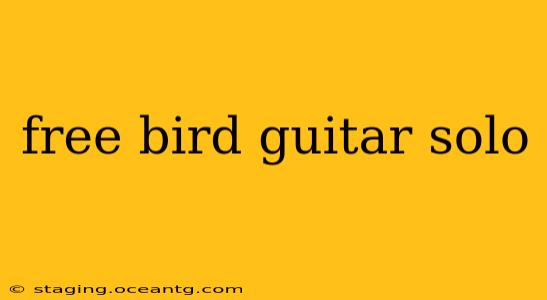Lynyrd Skynyrd's "Free Bird" isn't just a song; it's a cultural touchstone. And at its heart lies one of rock music's most legendary guitar solos, a sprawling, emotionally resonant masterpiece delivered by Allen Collins and Gary Rossington. This exploration delves into the magic of the "Free Bird" guitar solo, examining its structure, influence, and enduring legacy.
What Makes the Free Bird Guitar Solo So Iconic?
The "Free Bird" solo's iconic status isn't accidental. Several factors contribute to its enduring appeal:
-
Length and Improvisational Feel: Unlike many concise solos, this one stretches for several minutes, allowing for a captivating journey of musical exploration. The improvisational feel, while based on a framework, gives it a raw, energetic vibe that connects deeply with listeners.
-
Dual Guitar Harmonies: The interplay between Collins and Rossington's guitars is a key element. Their interwoven melodies and counterpoint lines create a rich tapestry of sound, far exceeding the capabilities of a single guitar.
-
Emotional Range: The solo isn't just a showcase of technical skill; it's a rollercoaster of emotions. It shifts from soaring highs to melancholic lows, mirroring the song's themes of freedom, loss, and longing.
-
Cultural Significance: "Free Bird" itself has become a staple of rock concerts, often requested enthusiastically by audiences. The solo, therefore, is intrinsically linked to this collective experience, amplifying its impact.
What is the Structure of the Free Bird Guitar Solo?
While the solo appears improvisational, it's built upon a strong foundation. It broadly follows a pattern of:
- Introduction: A brief, building section setting the stage for the main solo.
- Theme Development: The solo introduces a central melodic idea that is then developed and varied throughout.
- Harmonization and Counterpoint: Collins and Rossington's guitars interact, creating complex harmonies and counter-melodies that add depth and texture.
- Climax: The solo builds to a powerful peak, culminating in a series of soaring, sustained notes.
- Resolution: The solo gradually winds down, leaving a lingering impression.
It's important to note that even within this structure, there's significant room for improvisation and variation, resulting in slightly different versions in live performances.
How to Play the Free Bird Guitar Solo?
Mastering the "Free Bird" solo requires significant skill and practice. It's not a simple undertaking for aspiring guitarists. While numerous tablature and instructional videos are available online, successfully emulating the solo requires:
- Strong Fundamental Skills: A solid grasp of scales, modes, and improvisation techniques is crucial.
- Deep Listening and Ear Training: Truly understanding the nuances of the solo requires careful listening and an ability to transcribe and interpret the musical phrases.
- Patience and Persistence: It's a challenging solo that requires dedicated practice over a considerable period.
Who Played the Free Bird Guitar Solo?
The guitar solo in "Free Bird" is primarily credited to Allen Collins and Gary Rossington, the two main guitarists of Lynyrd Skynyrd. While some variations exist across live performances, the core elements were always a collaboration between these two gifted musicians.
What is the Meaning Behind the Free Bird Guitar Solo?
The meaning of the solo, like the song itself, is open to interpretation. However, many see it as a reflection of the band's Southern rock roots and their emotional connection to the themes of freedom and loss explored in the lyrics. The soaring highs and melancholic lows of the music might mirror the complexities of life and the bittersweet nature of both freedom and farewell.
The "Free Bird" guitar solo remains a testament to the power of musical improvisation, collaborative musicianship, and the enduring influence of Southern rock. Its iconic status is well-deserved and continues to inspire generations of guitarists.
